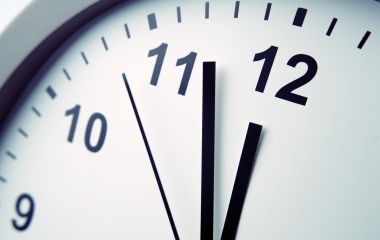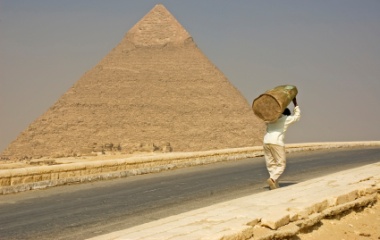
“It happened that Rabbi Eliezer, Rabbi Yehoshua, Rabbi Elazar ben Azariah, Rabbi Akiva and Rabbi Tarfon were reclining in B’nei Brak discussing the Exodus all night until their students arrived and said to them, ‘Rabbis, the time for reciting the morning Shema has arrived'”.
“Talmud Torah k’neged kulam”, the mitzvah of learning equals all others and may be interrupted only if there is an immediate and pressing need. On what basis did the students abrogate to themselves the right to interrupt their teachers? Even if it is true that it was proper to stop the story of the Exodus in order to say the morning Shema—a questionable assumption—it surely did not have to be said right then and there. One may recite the Shema up to three hours after daybreak and, while it may be optimal to do so right at daybreak, surely this does not warrant interrupting one's teacher.
From the above incident it would appear that there is a tension—if not an outright contradiction—between the mitzvah of sippur yetziat Mitzraim, retelling and reliving the Exodus, and that of the recital of the morning Shema. Once morning arrives, there is no longer any merit in recounting the story of the Exodus. Interestingly, the Haggadah emphasizes what is most obvious. While there is a mitzvah to recite the Shema both morning and evening, was it really necessary to state that, after staying up all night, it is the morning Shema one should recite?
So much about Pesach is connected to nighttime. “In the evening you shall eat matzah”; the Four Questions emphasize that it is this night that is different from all others. And clearly, the mitzvah of sippur yetziat Mitzraim is fulfilled only at night. Unlike Shabbat, one may not start Pesach early; and with the clocks now moved ahead in March, the start of the seder is often past the normal bedtime of our children.
Our descent into Egypt began at night. “And G-d spoke to Jacob in a vision at night and said, ‘Jacob, Jacob…do not be afraid to go to Egypt’” (Breisheet 46:2-3). It was at this moment that the covenant that G-d made with Abraham—“Know that your descendants will be strangers in a foreign land” (Breisheet 15:13)—was about to begin. This covenant was entered into, unsurprisingly, at night: “Look at the sky, and count the stars” (15:5).
That exile is associated with night is self-understood. Night represents fear, the unknown, darkness and despair. It is the time when one feels most vulnerable, and for good reason.
Yet in our way of thinking, exile marks the first necessary step in the redemptive process. “It was midnight, and G-d killed every firstborn in Egypt” (Shemot 12:29). The korban pesach, which demonstrated the ability of the Jews to defy their oppressors, can only be eaten at night. As we near the end of the seder, we sing “Vayehei b’chatzi halayla”, and it was at midnight, recounting the many miracles that were performed at night. “It is a night of watching for G-d to bring them out of Egypt” (12:42) is the model for all of Jewish history.
The tension between exile and redemption means Jewish history, unlike that of other nations, does not follow a linear path of ascent to power and descent onto oblivion. Even in the darkest periods of night, the seeds are planted for redemption. And even as redemption begins, there are still periods of night to set us back.
The Torah commands us to recite the Shema—and thereby remember the Exodus—morning and evening, in times of both fear and hope. The Shema begins with the command to “love the Lord your G-d”. While we must demonstrate love of G-d at all times, it is at “the time of morning Shema”, as the darkness dissipates, when it is easiest to do so.
It was the generation after the destruction of the Temple. Roman persecution was at its height, and the future looked bleak. Darkness was all around. The greatest rabbis of the day gathered at the home of Rabbi Akiva in B’nei Brak. They understood that even in darkness, the message of the Exodus must resonate through the night; so much so that they did not know at what point the night leads to day. They understood that night leads to morning, but they also knew morning leads to night. Only those young in years have the naive ability to see only hope in the future. Only youth have the necessary chutzpah to say that the night is over, there is no time to waste, let’s build that better future.
It is no coincidence that this story took place at the home of Rabbi Akiva; he is the symbol of Jewish hope. It was Rabbi Akiva who could laugh at the sight of foxes playing on the destroyed Temple Mount, and it was Rabbi Akiva who had the superhuman power and faith to recite the Shema as he was being martyred. And it is his model that the students followed.
As we mature, we acknowledge that reality tempers the idealism of our youth. Yet Pesach is a holiday that focuses on the children, on the hope for a better tomorrow. Only with that youthful, perhaps unrealistic, idealism and enthusiasm—at whatever age—will we merit the complete redemption. When idealism and realism merge as “the day will soon come that is neither night nor day…that bright as day will shine the darkness of the night” (Haggadah, Nirtzah). May that day come soon.
Chag Sameach!



